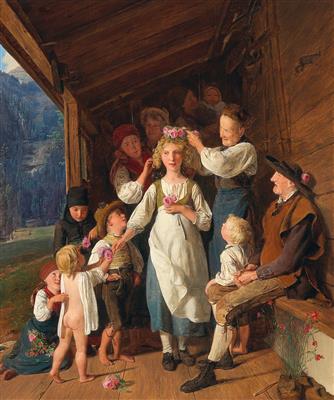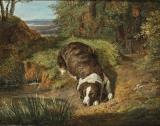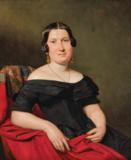Ferdinand Georg Waldmüller

(Vienna 1793–1865 Hinterbrühl)
The bridesmaid, signed, dated Waldmüller 1843, on the reverse old label Basel Kunsthalle 1943,
oil on panel, 50 x 42 cm, framed, (W)
Provenance:
Anton Oelzelt Ritter von Newin the Elder (1817-1875), Vienna;
Anton Oelzelt Ritter von Newin the Younger (1854-1925), Vienna;
His sale P. Kaeser, Vienna, 18 November 1878, lot 85;
Sale S. Kende, Vienna, 3 November 1919, lot 215;
Private Collection, Switzerland;
Sotheby’s, London, 30 May 2008, lot 7;
Private Collection, Austria;
Dorotheum, Vienna, 12 October 2010, lot 44;
European Private Collection.
Catalogued in:
Friedrich von Boetticher, Malerwerke des 19. Jahrhunderts, Hofheim am Taunus 1979, vol. II, 2, p. 969, no. 119;
Bruno Grimschitz, Ferdinand Georg Waldmüller, Verlag Galerie Welz, Salzburg 1957, CR no. 544;
Rupert Feuchtmüller, Ferdinand Georg Waldmüller 1793–1865, Leben. Schriften. Werke, Verlag Christian Brandstätter Vienna - Munich 1996, CR, no. 601, p. 478 (wrongly dated 1839).
Exhibited:Basel Kunsthalle, Ausstellung von Werken des 19. Jahrhunderts aus Basler Privatbesitz, 1943, no. 153,
Ferdinand Georg Waldmüller, 1793–1865, Österreichische Galerie Belvedere, Vienna 2010, exhibition catalogue, cat. no. 41, ill. p. 89.
Waldmüller was almost 50 before he began to claim the field of genre painting as his own. His preferred subject matter was depictions of farming communities and rural folk outside Vienna. He showed their daily lives, festivals, pleasures and hardships. His first important paintings in this genre are regarded in the literature as being the two pictures “After School”, dated 1841, and the “Peasant Wedding in Lower Austria”, dated 1843. This scene with the “Bridesmaid” was painted around the same time and depicts a familial event in which all generations partake. (Cf. Agnes Husslein-Arco, Sabine Grabner (pub.), Ferdinand Georg Waldmüller 1793–1865, Vienna 2009, exhibition catalogue, p. 133, 137f. and 222.). The scene is set in the entrance to a farmhouse in the Alps. To the left is a scene of sunlit mountains, a steep slope and a small stream, trees and pastures. In the centre of the painting stands a young girl, her grandmother fixing a wreath of roses on her curly blond hair. A second woman in the background arranges her hair. The girl looks away, a little self-conscious. In her left hand she holds several pink roses, pressed to her body. The other hand is stretched out to a small child who is handing her more roses. This small child functions as a repoussoir, leading the viewer’s eye to the centre of the picture. Here Waldmüller is uses both scenic and compositional elements to form connections: The bridesmaid’s head with her wreath represents the tip of a triangle, its two sides formed by the looks and gestures of the figures. The gestures, movements and looks of the figures standing in rows behind the young girl also create interactions which lend structure to the painting as a whole.
The dramaturgy of this painting is not only achieved through the individual groupings but also through the deliberate play of light. The daylight falling in from the left illuminates the girl’s white blouse and pinafore. The light coloured clothing of the children to the right and left completes the triangular composition noted above. The remaining figures are deliberately left dark, skilfully accentuating the strong contrast with the bridesmaid and her wreath. In addition to this natural-looking composition of figures, Waldmüller pays particular attention to the folk costume and accoutrements which he has so skilfully embedded into the painting and which today serve as a witness to the everyday objects of those times. For example, the artist has lovingly arranged a still life of flowers, twig and a felt slipper in the foreground. The focal point is of course the family group, the figures communicating with one another in a loving and respectful manner. The painting thereby depicts the simple contentment of everyday life; Klaus Albrecht Schröder speaks of so-called contentment paintings (Schröder, cit.op., p. 38).
Esperta: Dr. Christl Wolf
 Dr. Christl Wolf
Dr. Christl Wolf
+43-1-515 60-377
19c.paintings@dorotheum.at
19.10.2017 - 18:00
- Prezzo realizzato: **
-
EUR 247.000,-
- Stima:
-
EUR 200.000,- a EUR 250.000,-
Ferdinand Georg Waldmüller
(Vienna 1793–1865 Hinterbrühl)
The bridesmaid, signed, dated Waldmüller 1843, on the reverse old label Basel Kunsthalle 1943,
oil on panel, 50 x 42 cm, framed, (W)
Provenance:
Anton Oelzelt Ritter von Newin the Elder (1817-1875), Vienna;
Anton Oelzelt Ritter von Newin the Younger (1854-1925), Vienna;
His sale P. Kaeser, Vienna, 18 November 1878, lot 85;
Sale S. Kende, Vienna, 3 November 1919, lot 215;
Private Collection, Switzerland;
Sotheby’s, London, 30 May 2008, lot 7;
Private Collection, Austria;
Dorotheum, Vienna, 12 October 2010, lot 44;
European Private Collection.
Catalogued in:
Friedrich von Boetticher, Malerwerke des 19. Jahrhunderts, Hofheim am Taunus 1979, vol. II, 2, p. 969, no. 119;
Bruno Grimschitz, Ferdinand Georg Waldmüller, Verlag Galerie Welz, Salzburg 1957, CR no. 544;
Rupert Feuchtmüller, Ferdinand Georg Waldmüller 1793–1865, Leben. Schriften. Werke, Verlag Christian Brandstätter Vienna - Munich 1996, CR, no. 601, p. 478 (wrongly dated 1839).
Exhibited:Basel Kunsthalle, Ausstellung von Werken des 19. Jahrhunderts aus Basler Privatbesitz, 1943, no. 153,
Ferdinand Georg Waldmüller, 1793–1865, Österreichische Galerie Belvedere, Vienna 2010, exhibition catalogue, cat. no. 41, ill. p. 89.
Waldmüller was almost 50 before he began to claim the field of genre painting as his own. His preferred subject matter was depictions of farming communities and rural folk outside Vienna. He showed their daily lives, festivals, pleasures and hardships. His first important paintings in this genre are regarded in the literature as being the two pictures “After School”, dated 1841, and the “Peasant Wedding in Lower Austria”, dated 1843. This scene with the “Bridesmaid” was painted around the same time and depicts a familial event in which all generations partake. (Cf. Agnes Husslein-Arco, Sabine Grabner (pub.), Ferdinand Georg Waldmüller 1793–1865, Vienna 2009, exhibition catalogue, p. 133, 137f. and 222.). The scene is set in the entrance to a farmhouse in the Alps. To the left is a scene of sunlit mountains, a steep slope and a small stream, trees and pastures. In the centre of the painting stands a young girl, her grandmother fixing a wreath of roses on her curly blond hair. A second woman in the background arranges her hair. The girl looks away, a little self-conscious. In her left hand she holds several pink roses, pressed to her body. The other hand is stretched out to a small child who is handing her more roses. This small child functions as a repoussoir, leading the viewer’s eye to the centre of the picture. Here Waldmüller is uses both scenic and compositional elements to form connections: The bridesmaid’s head with her wreath represents the tip of a triangle, its two sides formed by the looks and gestures of the figures. The gestures, movements and looks of the figures standing in rows behind the young girl also create interactions which lend structure to the painting as a whole.
The dramaturgy of this painting is not only achieved through the individual groupings but also through the deliberate play of light. The daylight falling in from the left illuminates the girl’s white blouse and pinafore. The light coloured clothing of the children to the right and left completes the triangular composition noted above. The remaining figures are deliberately left dark, skilfully accentuating the strong contrast with the bridesmaid and her wreath. In addition to this natural-looking composition of figures, Waldmüller pays particular attention to the folk costume and accoutrements which he has so skilfully embedded into the painting and which today serve as a witness to the everyday objects of those times. For example, the artist has lovingly arranged a still life of flowers, twig and a felt slipper in the foreground. The focal point is of course the family group, the figures communicating with one another in a loving and respectful manner. The painting thereby depicts the simple contentment of everyday life; Klaus Albrecht Schröder speaks of so-called contentment paintings (Schröder, cit.op., p. 38).
Esperta: Dr. Christl Wolf
 Dr. Christl Wolf
Dr. Christl Wolf
+43-1-515 60-377
19c.paintings@dorotheum.at
|
Hotline dell'acquirente
lun-ven: 10.00 - 17.00
kundendienst@dorotheum.at +43 1 515 60 200 |
| Asta: | Dipinti dell’Ottocento |
| Tipo d'asta: | Asta in sala |
| Data: | 19.10.2017 - 18:00 |
| Luogo dell'asta: | Wien | Palais Dorotheum |
| Esposizione: | 07.10. - 19.10.2017 |
** Prezzo d'acquisto comprensivo di tassa di vendita e IVA
Non è più possibile effettuare un ordine di acquisto su Internet. L'asta è in preparazione o è già stata eseguita.
Altri oggetti dell'artista
-

Stima:
EUR 35.000,- a EUR 45.000,- -

Stima:
EUR 18.000,- a EUR 25.000,- -

Stima:
EUR 12.000,- a EUR 18.000,-
